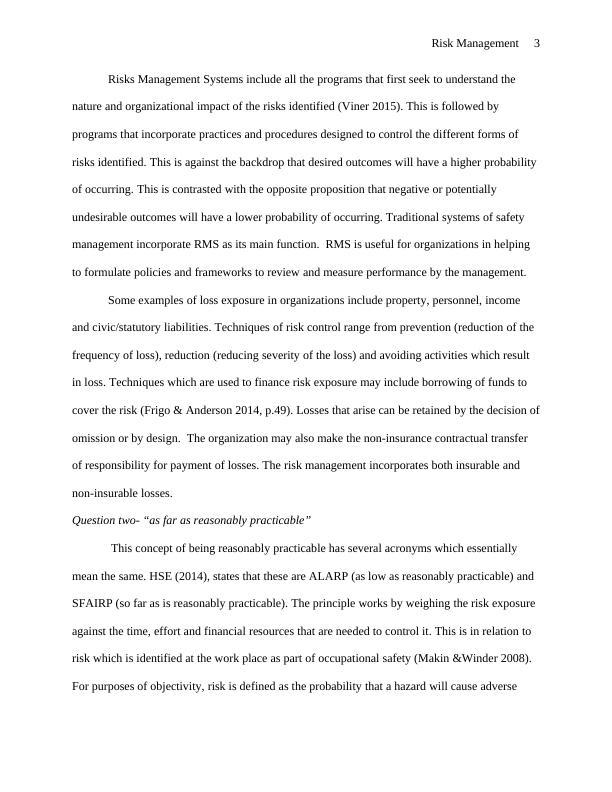FIN4232 - Assignment on International Risk Management
Added on 2020-03-07
10 Pages2792 Words56 Views
Risk Management 1RISK MANAGEMENTAuthorCourseProfessorUniversityCity, StateDate

Risk Management 2RISK MANAGEMENTQuestion one- Risk Management in preventing lossRisk management can be defined as the continuous process that is used to identify and analyze exposures that may result in loss. The exposures identified are then evaluated as to their severity and appropriate mitigation measures taken. The International Risk Management Standard sets out principles that are relevant in the risk management process at different levels ofdecision making (Marquette University 2017). Arnesen & Foster (2016, p.40) state that these include decisions made with regards to policy development, management of contracts, decisions on purchasing and outsourcing of services using matrices of probability and impact. The International Standard sets out steps that may be taken in the process of mitigating the risks and loss (Marquette University 2017). The first step is establishing the goals and loss context considerations. The hazards which are identified are evaluated after being analyzed. These may include financial risks (costs arising from claims and judgments of liability) and strategic risks (changes in management). It may also extend to operational risks (such as labour disruptions) and perimeter risks (changes in political landscape and weather). The hazards are then controlled and monitored regularly and communicated to the stakeholders. Risk management programs or systems (RMS) are centered on the costs associated with risk. The costs associated with risk include losses retained in the form of retentions and deductibles. Net proceeds from insurance and costs allocated for control of loss activities are alsoincluded. Costs of administering the program relating to mitigating loss are included as part of the costs of risk (Marquette University 2017). The expenses attached to managing the process of claims also contributes to the overall costs of controlling risk. The totality of the above costs when measured as an aggregate should results in an overall saving for the organization. This is despite some elements of the above showing net increase or decrease in cost individually.

Risk Management 3Risks Management Systems include all the programs that first seek to understand the nature and organizational impact of the risks identified (Viner 2015). This is followed by programs that incorporate practices and procedures designed to control the different forms of risks identified. This is against the backdrop that desired outcomes will have a higher probability of occurring. This is contrasted with the opposite proposition that negative or potentially undesirable outcomes will have a lower probability of occurring. Traditional systems of safety management incorporate RMS as its main function. RMS is useful for organizations in helping to formulate policies and frameworks to review and measure performance by the management.Some examples of loss exposure in organizations include property, personnel, income and civic/statutory liabilities. Techniques of risk control range from prevention (reduction of the frequency of loss), reduction (reducing severity of the loss) and avoiding activities which result in loss. Techniques which are used to finance risk exposure may include borrowing of funds to cover the risk (Frigo & Anderson 2014, p.49). Losses that arise can be retained by the decision ofomission or by design. The organization may also make the non-insurance contractual transfer of responsibility for payment of losses. The risk management incorporates both insurable and non-insurable losses.Question two- “as far as reasonably practicable” This concept of being reasonably practicable has several acronyms which essentially mean the same. HSE (2014), states that these are ALARP (as low as reasonably practicable) and SFAIRP (so far as is reasonably practicable). The principle works by weighing the risk exposure against the time, effort and financial resources that are needed to control it. This is in relation to risk which is identified at the work place as part of occupational safety (Makin &Winder 2008). For purposes of objectivity, risk is defined as the probability that a hazard will cause adverse

End of preview
Want to access all the pages? Upload your documents or become a member.
Related Documents
Risk Management System for Airlines: Importance, Implementation and Elementslg...
|10
|2124
|214
Qualitative and Quantitative Assessment of Riskslg...
|5
|1076
|283
Risk Assessment and Control Management in Librarieslg...
|11
|2198
|424
Risk Management System for Railway Transport: Identification, Analysis and Mitigationlg...
|13
|3250
|355
Risk Management in Industrial Plantslg...
|12
|5048
|492
Respirable Crystalline Silica (RCS) as a Health Hazardlg...
|30
|6433
|246
